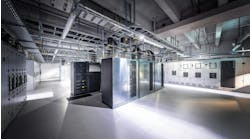In this edition of Voices of the Industry, Jeff Klaus, General Manager of Intel Data Center Management Solutions, explains how Intel DCM enables CIOs, IT and facilities teams to travel the same path. The above video further explores how to modernize your date center with Intel DCM.
Jeff Klaus, GM of Intel Data Center Management Solutions
It’s been said that today’s data center is the railroad infrastructure of our Digital Age, and that the world’s business travels along its rails. As we witness the proliferation of Big Data analytics and the advent of IoT, Artificial Intelligence and Machine-to-Machine (M2M) technologies across the enterprise, the metaphor has never been more appropriate as organizations pursue their digital transformation.
To embrace these game-changing technologies and their potential to transform the data center from a cost center into a strategic vehicle that increases business agility and profitability, it is in the mutual interest of the data center manager, facilities staff and C-suite executive to work together to satisfy their many overlapping business requirements by the most cost-effective means possible. But in many enterprises, the CIO, IT and data center facilities teams work separately and with little communication.
This failure to communicate, compounded by data center environments that may be hamstrung with legacy equipment, often leads to conflict — avoidable conflicts, as we shall see. For example, the IT department, which is rarely responsible for the data center’s electric bill, may not be aware of how their activities are impacting a facility’s power expenditures. And since they lack transparency into how much power they are using, they may fail to enable power management and cooling options.
This lack of insight gives IT organizations less incentive to operate their data center environment more efficiently, and the gap between IT and facilities can result in lower productivity, slowed service deployment, inefficient equipment, lost revenue, increased expenses and unscheduled downtime.
It’s these last two points that should give the C-suite executive pause. According to the Ponemon Institute, the cost of an unplanned data center outage is now approximately $9,000 per minute. North American businesses alone collectively lose $26.5 billion each year due to IT downtime and data recovery. As for OpEx, Gartner predicts that by 2020, data centers in the United States alone will require six times the electricity consumed by New York City in a single year. As we all know, energy costs continue to be the fastest-rising expense for today’s data centers.
Towards the Goal of Digital Transformation with an Eye on the Bottom Line
With out-of-the box support that allows you to painlessly save on CapEx and OpEx, Intel Data Center Manager (DCM) is the easiest way to modernize your data center, providing complete visibility and control as well as remote management. Intel DCM’s intelligent software provides real-time power and thermal consumption data, lending the clarity that IT staff needs to lower power usage and increase rack density to maximize the full value of infrastructure. Additionally, by monitoring for component failures before they can create a problem, downtime is minimized and data center managers can continue or prolong operations during power outages.
Intel Data Center Manager provides power and thermal monitoring and management for servers, racks, and groups of servers in data centers. By using existing servers as wireless sensors and analyzing the data they already collect, these data-driven insights enable business users to achieve the performance levels they require.
[clickToTweet tweet=”Jeff Klaus – Intel DCM is hardware agnostic, leveraging firmware capabilities present within most modern #servers.” quote=”Jeff Klaus – Intel DCM is hardware agnostic, leveraging firmware capabilities present within most modern #servers.”]
Intel DCM is hardware agnostic, leveraging firmware capabilities present within most modern servers. The key advantage is that data center managers working with legacy equipment, who want the benefit of granular power monitoring but also to avoid the prohibitive extra cost of installing intelligent power strips and UPSs, can monitor the active components that really matter.
Intel DCM enables data centers to leverage investments in systems already present, lower costs by optimizing power and cooling resources, and minimize costly downtime. And by this means, enterprise CIOs, IT and facilities teams can finally start down the same track more confidently, and with a shared vision as they pursue their organization’s digital transformation.
Jeff Klaus is the General Manager of of Intel Data Center Management Solutions.





